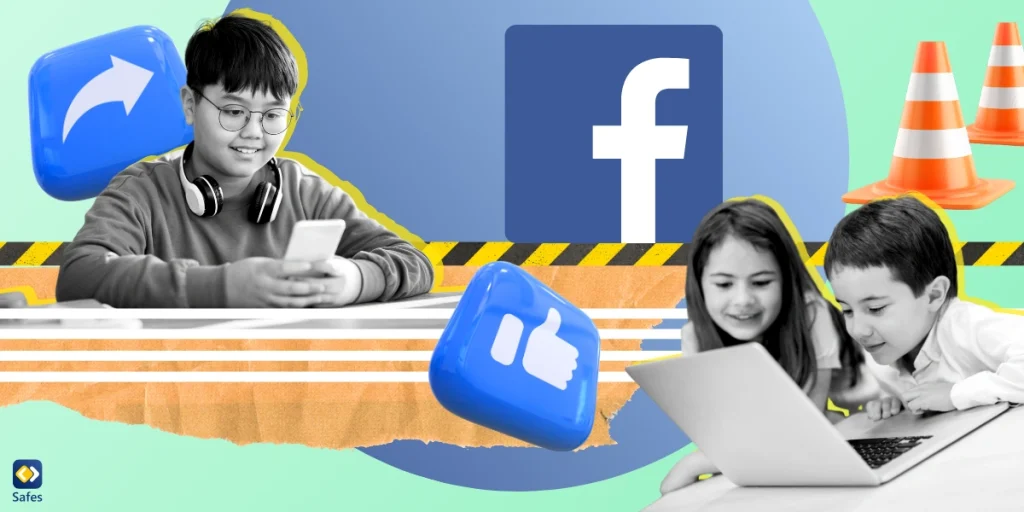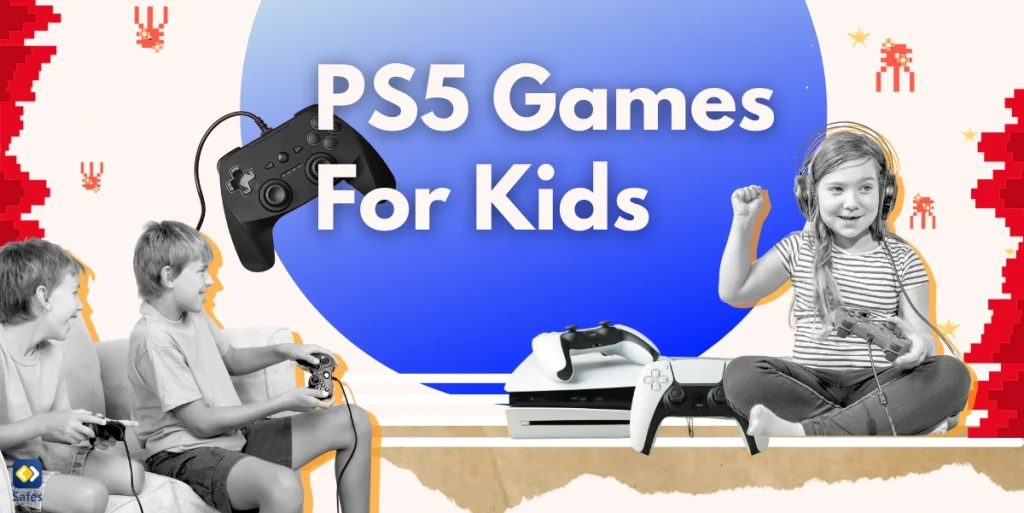Facebook has almost three billion users and, being one of the most popular messaging apps, there’s probably no need to introduce the social media platform. Many of Facebook’s users are under 18 years of age so it makes sense for there to be Facebook parental controls. In this blog post, we’ll learn whether Facebook is safe for children and how to block inappropriate content on Facebook.
Download and Start Your Free Trial of the Safes Parental Control App
Is Facebook Safe for Children?
Facebook’s minimum age requirement is 13 years old. This is due to legal reasons and compliance with the Children’s Online Privacy Protection Act (COPPA) in the United States. Since Facebook for kids under 12 is technically illegal, delete your child’s Facebook account if they’re under 13 years of age. If they’re within the age limit, let’s talk about the risks your teenager faces on the platform.
The Facebook app, like any other online platform, carries certain risks and potential dangers. Here are some of the common dangers associated with Facebook use:
- Privacy concerns: Facebook collects a considerable quantity of personal information from users. Although this information may be used to tailor advertisements, it also runs the risk of compromising privacy. Users may unintentionally disclose personal information that might be misused by malicious actors or utilized for identity theft.
- Cyberbullying: Cyberbullying may occur on Facebook, where users have the ability to insult others or to harass, threaten, or intimidate them. The victims may experience significant emotional and psychological effects as a result.
- Online predators: Facebook and other social networking sites may draw internet predators who aim to prey on the defenseless, especially young children. Fortunately, these people can be added to the block list.
- Addiction and mental health issues: Facebook and other social networking sites may lead to addiction and have a severe impact on mental health if used excessively. Anxiety, depression, and low self-esteem can result from constant comparison, online jealousy, and the pressure to maintain an idealized online identity.
- Scams and frauds: Facebook has the potential to act as a haven for many scams and fraud types. Users may come across deceptive marketing tactics, phishing scams, or dishonest methods intended to trick them and steal their money or personal data.
Facebook Parental Control Settings
Let’s see how to put parental controls on Facebook. You can only turn on Facebook parental controls from your child’s account. If this is the first time your child opens an account on Facebook, you can create a Facebook account for your child. When creating a Facebook account for your child, you will have to create a completely new account just as you would for an adult. There is no way that you can create a Facebook child account through your own Facebook page. You can check out this video or read the steps below to set up parental controls on Facebook.
If a Facebook account for your child already exists, ask them to log in and also give their account credentials to you. After logging in, follow these steps:
- Click your child’s profile picture in the top right corner of the screen.
- On the menu that appears, click ‘Settings & Privacy’.
- Click on ‘Privacy Checkup’.
You’ll be directed to a new page where you can view and change all the privacy settings, which can practically be called Facebook’s parental controls, broken up into five sections:
- Who Can See What You Share
- How to Keep Your Account Secure
- How People Can Find You on Facebook
- Your Data Settings on Facebook
- Your Ad Preferences on Facebook

Who Can See What You Share?
In this section, you can decide who can see your child’s:
- Phone Number
- Email Address
- Date of Birth
- Hometown
- Relationship Status
- Current City
- Post & Stories
We suggest you set information such as phone numbers, emails, and hometown to ‘Only Me’. If you do that, no one but your child can see it. Other information like their birthday and the current city could be set to ‘Friends’, meaning that your child’s friends on Facebook can see it.
You can also define your child’s default post and story audience here. To maximize your child’s privacy, we suggest you set it to ‘Friends’. Lastly, in this section, you can block Facebook users. If there are any people in particular whom you don’t want your child to interact with, look them up and block them.
How to Keep Your Account Secure
In this section, you can change your child’s:
- Password
- Notifications
You may update the password or activate two-step verification. You can also set how to receive notifications when an unrecognized device logs into your child’s account. You may want to add your own email address to the account settings so that you can receive login alerts.
How People Can Find You on Facebook
In this section, you can define:
- Who can send friend requests to your child
- Who can look your child up using their phone number and email
- If search engines can index your child’s account
We suggest you let ‘Friends of Friends’ (meaning your child’s friends of friends on Facebook) send friend requests to your child. Also, it is better to let no one other than your child’s ‘Friends’ look up your child’s account using your child’s email address or phone number. Finally, deactivate search engine indexing. Otherwise, anyone using Google, or any other search engine can look up your child’s account.
Your Data Settings on Facebook
In this section, you can see the websites or apps your child has logged into using Facebook. You can use your Facebook account (like a Gmail account) to log into different websites, which is almost always not a threat. You may terminate any of them your child doesn’t use; however, it is unnecessary. Perhaps the best use of this section from a parental control point of view is that it gives you an idea of what other websites your child uses. Some of them might be inappropriate.
Your Ad Preferences on Facebook
In this section, you can modify:
- The ads your child sees
- Your child’s social interactions that others can see
Unfortunately, you cannot decide whether to see or not see ads on Facebook. Showing ads is how Facebook makes money. However, in some way, you can tell Facebook what kind of ads to show your child. Facebook collects information from all of its users to show them customized ads.
In this section, you are given options to turn on or off that can affect the kinds of ads your child sees. For example, you can let Facebook use your child’s educational history or hometown. We suggest you turn all the options off. However, it doesn’t mean your child won’t be shown ads or Facebook won’t collect data from your child.
Facebook shows notifications from any user’s interactions with their friends. That means your child’s friends might be notified if your child follows a page or likes and comments on their posts. Facebook calls this feature ‘Social Interaction’. We suggest you set it to ‘Only Me’ because this feature risks your child’s privacy.

Are Facebook Parental Controls Enough?
Facebook’s monitoring features aren’t really parental controls. In fact, they’re just the settings that any user can change on their profile. They’re not enough to block inappropriate content on Facebook. Even if you change the settings for a Facebook parent-child account, they can change it easily when you’re gone. Since your child has a Facebook account in the first place, they’re probably over 13 years old. This means that they’re more than tech-savvy enough to change such simple settings.
If you really want to monitor your child’s digital life and ensure their safety on social media platforms, use other types of parental controls. The device your child uses probably has a default set of parental controls. But if you want to have access to the best set of parental control features that are available, use a third-party parental control app. Safes is one example. Safes allows you to:
- Manage your child’s screen time
- Set smart schedules for apps separately
- Track your child’s location in real-time
- Block access to all inappropriate types of content
Safes also has other features excellent for parental control. Join us in creating a safer digital world for your child! Kickstart your digital parenting journey with Safes’ free trial. Sign up today to experience advanced parental control features and provide comprehensive protection. Get started now for peace of mind!
Conclusion
To enable Facebook parental controls, you have three options:
- Use the Facebook parent-child account privacy settings already available on Facebook
- Use the default parental controls on your child’s device
- Use a third-party parental control app
Each of these options has its own pros and cons. You can even use them simultaneously for different reasons. Hopefully, by learning how to put parental controls on Facebook, you will be able to keep your child safe on this social media platform.
Your Child’s Online Safety Starts Here
Every parent today needs a solution to manage screen time and keep their child safe online.
Without the right tools, digital risks and excessive screen time can impact children's well-being. Safes helps parents set healthy boundaries, monitor activity, and protect kids from online dangers—all with an easy-to-use app.
Take control of your child’s digital world. Learn more about Safes or download the app to start your free trial today!




